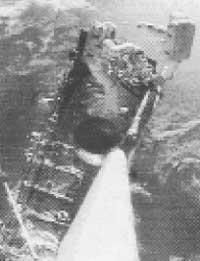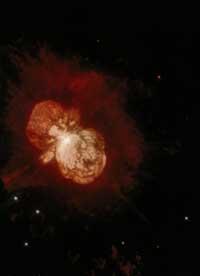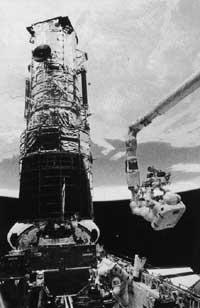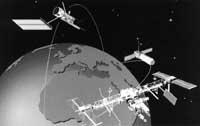Repair Hubble
1994/01/01 Arregi Bengoa, Jesus Iturria: Elhuyar aldizkaria
However, as stated at the end of the article, all work done to date (75% of the mission) has been done without any problem. However, despite the complete mission, it will take another 6 or 8 weeks to properly adjust all the tools and collect the first photos. That is, although all the works have been done well, we do not know if the effort has been really successful until February.
This DNA mission is a program that deserves special attention. According to experts, the program of this flight is the most complicated that has been organized after the Apollo that took the man to the Moon. Although NASA has been in charge of organizing and controlling the Endeavour trip, ESA has also participated, as we will see later.

The participation of the EEA began with 15% in the HST program, but due to further work it has extended to 20%. Thus, European scientists will be able to take advantage of 20% of the observation time.
The Discovery repulsion put the HST into orbit on April 24, 1990. It was then that the technicians realized the error of the main mirror of the telescope: The 2.4 m diameter reflector has a polishing failure and its bending radius is larger than necessary. In fact, the mirror blades should be 2.34 microns higher than the existing ones. Consequently, the telescope has a spherical aberration of 95%, the images are sketched and the resolution is only a fifth of the calculated. However, the symmetry of the polish is excellent and therefore the error is also symmetrical. Thus, Endeavour astronauts will strive to correct it through an appropriate optical system.
It must be said, however, that the results of the Hubble Telescope have not been bad, but they have not met the expectations of astrophysicists. If the repair is carried out as planned, the telescope could find evidence of black holes and systems similar to the Solar System, of information that otherwise cannot be obtained in any way about the quasars and the consequences that could be derived from the evolution of galaxies would be of great importance. Quite precise values of the Hubble constant and the slowdown of the Universe could also be calculated. From all these data one could calculate the age and density of the Universe. With this you can decide whether the open Universe is like that and whether it expands forever or shrinks again.
Mirror error has not been the only problem that has appeared after the incorporation of HST. Soon began to highlight in the instrumentation of the telescope the vibration caused by the plates to take advantage of solar energy. These twelve metre long plates were manufactured under the responsibility of LSA and do not bear well the enormous temperature change between the day of the telescope and the night, although their duration is about 90 minutes. The wide field camera also needs a correction of the blurred images it receives from the main mirror.
To solve the visual failure of the mirror is designed a tool composed of ten lenses called COSTAR. COSTA compensates for the curvature error of the main mirror, but by simultaneously absorbing light, the telescope will never be able to improve the expected resolution of around 80%. The high-speed photometer will be the only device to lose in order to put “glasses” to the telescope.
Solar panels have also been redesigned, which must be folded, removed and replaced by new ones.
In the case of wide field cameras, one of them will take corrected images after the placement of the STAR and has decided to replace the other. In addition to some technical improvements, the corrector will be matched.
On the other hand, two magnetrometers and three gyroscopes are deteriorated and, except for the third gyroscope, they will be attempted to modify. However, it is fair to say that the HST is designed to be repaired in orbit and for maintenance. Therefore, it consists of several modules and has handles for astronauts. Finally, it is intended to take advantage of the journey to modify some electronic components and expand the memory of the telescope.
Suffice it to say that the work that Endeavour astronauts must perform in is difficult. For all these works on December 4 C. Nicollie, the only ESA astronaut on this flight, by approaching the wedge to the telescope, in an orbit of 587 km high, has skillfully conducted Endeavour's mechanical arm to locate the HST. In the coming days, from 5 December, five outings or foreign acts (EVA, Extravehicular Activities) have been carried out with an approximate duration of 7 hours to carry out the aforementioned works. Two astronauts leave each time. Two new departures have also been planned if special problems arise.
The seven astronauts have worked hard to train all jobs accurately and quickly: the workouts have been extended for over 700 hours, of which 400 have been made in special pools to simulate free space conditions. Any simple work on the floor, such as the tying of a screw, is very difficult in the empty space if you have to do it outside the boat. It must be said that one of the greatest fears of astronauts is the deterioration of some of its basic parts in the resolution of the telescope.
So far the news is very good. After a few hours of delay due to bad weather, Endeavour departed on December 2 at 10 h 27 min. On December 4 he approached and tied the telescope and since then four EVs have been made in which gyroscopes, magnetometers, solar panels and the wide field camera have been changed, placing COSTAR in place. We hope that the program will continue to be successful.
Ephemeris SUN: January 20, at 7h 7min (UT) the Sun enters Aquarius. The Earth passes through the perihelion on January 2.
PLANETS MERCURY: is in superior conjunction on January 3, making it invisible. We can try it the last days of the month before the Sun rises. |

Gai honi buruzko eduki gehiago
Elhuyarrek garatutako teknologia





